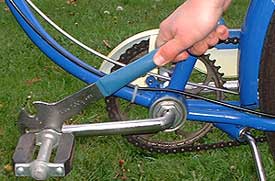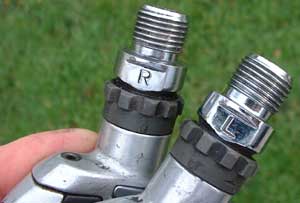How To Remove And Install Pedals
Required tools: There are special "pedal wrenches" available that are long for optimum leverage and have thin jaws to fit onto narrow pedal axles for a good purchase. Depending on what pedals you have, you might be able to use a regular combination wrench instead (most pedals are 15mm). Note that some pedals are installed and removed with an Allen wrench (photo). You’ll need one with a long handle. Or, you can attach a piece of tubing to lengthen your wrench and improve the leverage you have.
The most common reason to remove pedals is to upgrade or to switch a pair from one bike to another. You also must remove the pedals when you ship your bicycle in a bike box.
Pedal removal and installation is trickier than it looks. Because pedal axles are usually made of steel and crankarms are usually aluminum, there's the possibility of the hard pedal threads stripping the soft aluminum ones. Also, pedal threading is unusual and confusing. The right (drivetrain side) pedal has regular threading (clockwise turns tighten it; counter-clockwise turns loosen it). The left, however, is the opposite. What's more, pedals are often attached to the crankarms super tightly, which can make removal quite difficult.
Removal
Most pedals have flat spots on the axle near the crankarm for the wrench to grip. If you don’t see any flats, your pedal probably requires an Allen key, in which case, the hole for the tool will be in the end of the pedal axle.
Safety tip: If your bike has more than one chainring, before trying to loosen pedals, shift onto the large chainring. This will help ensure that if you slip when working on the pedals, you won’t slam your hand directly into the chainring teeth. Also, try to keep your hand on the topside of the wrench. This keeps the wrench between your hand and your chainrings and is an extra measure of protection in the event of a mishap.
There are 3 “secrets” to easy pedal removal:
1. Turn the wrench the right way (to loosen the right and left pedal, the wrench is turned towards the back of the bike).
2. Position the wrench alongside the crankarm for optimum leverage. When it’s right, you’ll be able to push toward the crankarm (photo right). If this isn’t possible with your wrench, try a different type.
3. Use a pedal wrench with a long handle or attach a “cheater” bar, such as a length of pipe, to your wrench.
Installation:
One of the reasons pedals can be difficult to remove is lack of lubrication. So, be sure to grease the pedal threads before installation. Then look closely at the pedal axles or ends to see which side they belong on. You should see a little “R” and “L,” (photo below) for “Right” and “Left.” Note that French pedals sometimes have “D” and “G” for “Droit” and “Gauche.” 
Choose the appropriate pedal and start it into the correct crankarm by hand turning the pedal axle toward the front of the bike (both pedals thread in this direction). If it won’t start, don’t force it! You’re probably trying to install the left pedal on the right side or vice versa.
Thread both pedals into the crankarms as far as you can by hand. Then fully tighten them with the pedal wrench. It’s important to get pedals good and snug so they can’t loosen from pedal pressure. This can be difficult with pedals requiring an Allen wrench if you only have a short tool. For these, use a cheater bar to ensure adequate tightness.
